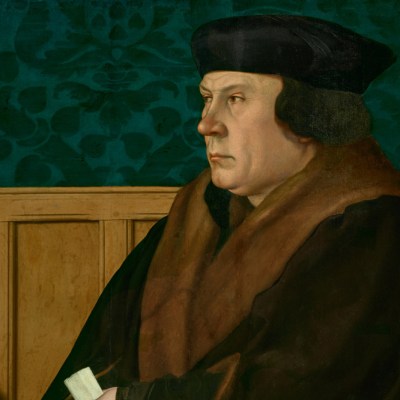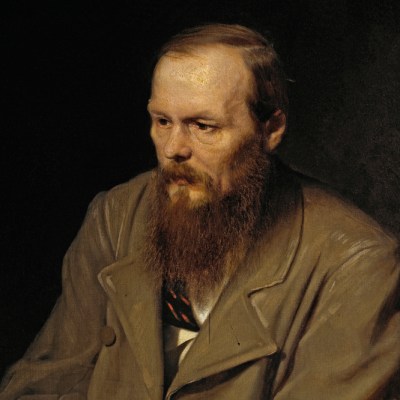In August 1867, Fyodor and Anna Dostoevsky were in Basel, fleeing debts in Russia. In the Kunstmuseum they stopped before Hans Holbein the Younger’s Dead Christ in the Tomb, the claustrophobic, unusually formatted panel of 1521–22. According to Anna’s diary, ‘Fyodor was completely carried away by it, and in his desire to look at it closer got on a chair, so that I was afraid that he would have to pay a fine, like one is always liable to here.’ At first glance it is strange that Dostoevsky admired Holbein so rapturously, an encounter he staged again in The Idiot. After all, Holbein never belonged to the Romantic cult of the German Renaissance that revered Dürer, Altdorfer, and Grünewald. But then, no other Renaissance painter manipulates the physical posture of the viewer like Holbein. The Dead Christ brought Dostoevsky up on to a chair. The Ambassadors, in the National Gallery, brings its audience absurdly to the lower left corner to see the vanitas skull from the sharpest possible angle. And ‘Holbein: Capturing Character’, which has arrived at the Morgan Library in New York from the Getty in Los Angeles, will make its guards nervous.
That is because the exhibition zooms in on Holbein the miniaturist. In two rooms, it frames and explains Holbein’s portraiture by means of the marginal, small and ephemeral productions of his career in Basel and London: preparatory drawings, borders for the title pages of humanist books, and above all jewels, badges and emblems. In that sense, the absence of the Dead Christ and Ambassadors is refreshing. It allows the objects on display to make a revelatory and coherent argument about the construction of identity in Tudor Europe.
In one of etymology’s great mysteries, the ancient Greek word for stamp or impression became the English word ‘character’. ‘Holbein: Capturing Character’ launches the viewer into a world where this transformation was under way but far from complete. When John Leslie wrote in 1569 of ‘the Quenes verie character’, he referred not to any intrinsic quality of her soul, but to her handwriting. Nobody explored this grey zone of shifting categories as intrepidly as Erasmus, the humanist scholar whose patronage launched Holbein’s career in England. In 1509, the archbishop of St Andrews gave Erasmus an ancient Roman gem set into a golden ring, on display here. Erasmus thought that the gem was engraved with an image of Terminus, the Roman god of boundaries with the motto I yield to nobody, and he identified with it so strongly that he stamped it into the wax seal of the thousands of letters he sent across Europe. (In fact the gem shows Dionysus, sending a rather different message.) Holbein painted Erasmus more than once; classic portraits are in Paris and London, and an intimate roundel portrait from the last years of his life is in the exhibition. But the most bizarre and fascinating is his portrait of Erasmus as Terminus, in which a head vaguely reminiscent of the Dutch scholar rests on a Roman herm in a dark, desolate landscape. It is a character study in two senses, an image of a man who has become his signature.
Terminus, the Device of Erasmus (c. 1532), Hans Holbein the Younger. Cleveland Museum of Art

Verisimilitude, to be sure, mattered to Holbein’s patrons. Erasmus complained that Dürer’s engraving of 1526 showing him at his desk looked nothing like him. When he saw the drawing of himself that Holbein, as a teenager, had scratched into the margin of the Praise of Folly – the beginning of Holbein’s career-long engagement with the printed book – he said, ‘Alas, if Erasmus still looked like that, he would actually be able to find a wife.’ More than 20 years later, the same joke played out again, with higher stakes. Henry VIII sent Holbein to the continent to paint Anne of Cleves and Christina of Denmark, candidates for his fourth wife, as closely as possible. Legend blames the failure of the king’s marriage to Anne of Cleves within six months on a mismatch between her and her portrait.
But the human face was only one stamp among others. In The Autumn of the Middle Ages (1919), the Dutch historian Johan Huizinga wrote about the personal paraphernalia that signalled belonging in the 15th century: ‘The lover wore the colours of his lady; companions the emblem of their confraternity; parties and servants the badges or blazons of their lords.’ The exhibition reminds us that this world had not vanished by the 16th century, and a display case full of these hard-to-find ephemera is one of the show’s real highlights. These badges are gaudy, not to say kitschy: a decapitated head of John the Baptist surrounded by bright red blood; a phantasmagoric scene of the binding of Isaac with gold, blues, greens and jewels – five figures, two animals, a landscape and a city – on an object less than three inches in diameter. Yet Holbein treasured objects like these and designed on this scale, including in watercolours and ink drawings that he kept in a Jewellery Book.
Medallion of Lot with his family (c. 1532–43), from Hans Holbein the Younger’s Jewellery Book. British Museum, London

Portrait of a Lady, probably a Member of the Cromwell Family (c. 1535–40), Hans Holbein the Younger. Toledo Museum of Art. Photo: via Wikimedia Commons (public domain)

After being acclimated to this strange world, we approach the portraits with new eyes. I noticed for the first time the ring on Thomas More’s left index finger in the portrait loaned here from the Frick. In the preparatory drawing of William Parr, Henry VIII’s sixth wife’s brother, Holbein sketched all the jewellery he hoped to include on the margin of the sheet, as though making a catalogue. One of the designs of the Jewellery Book became the medallion of Lot and his family hanging from the neck of his Portrait of a Lady. In the show’s most remarkable portrait, the freshly restored Simon George of Cornwall from Frankfurt, the sitter’s hat is studded with badges. The catalogue claims that one shows the myth of Leda and the Swan, identifying George as a lover. You would have to do a Dostoevsky to find out for sure; to me, it looks like an archipelago.
Simon George of Cornwall (c. 1535–40), Hans Holbein the Younger. Städel Museum, Frankfurt

The only person whose identity remains indecipherable is Holbein. There is no self-portrait here; Holbein was never as interested in his own image as Dürer. What there is, instead, is the Allegory of Passion, a lozenge-shaped painting of a mercurial man on a galloping horse above the Petrarchan line E cosi desio me mena (‘And so desire carries me along’). The object is a personal badge writ large, but whose character it represents remains an open question. It could share a title with another work in the show: Portrait of an Unknown Man.
An Allegory of Passion (c. 1532–36), Hans Holbein the Younger. J. Paul Getty Museum, Los Angeles

‘Holbein: Capturing Character’ is at the Morgan Library & Museum, New York, until 15 May.
From the March 2022 issue of Apollo. Preview and subscribe here.



